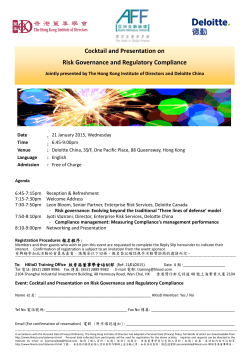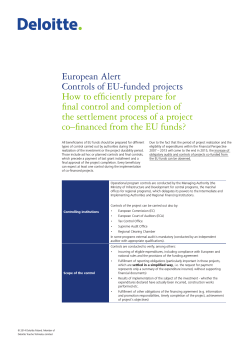
Multistate Tax EXTERNAL ALERT IRS Issues Guidance on Imposition of the Federal Oil Spill Tax on Tight Oil February 24, 2015 Overview The Internal Revenue Service (“IRS”) Office of Chief Counsel recently issued IRS Program Manager Technical Assistance 2014-10 (“PMTA 2014-10”),1 which provides guidance on the imposition of the Federal Oil Spill Liability Trust Fund tax (“Oil Spill Tax”) on “tight oil”2 extracted from the Bakken Formation underlying parts of Montana and North Dakota in the United States and Saskatchewan and Manitoba in Canada. Although PMTAs do not constitute precedential authority, they indicate the position the IRS may take when subsequently addressing the same issue. In PMTA 2014-10, the IRS concluded that tight oil extracted from the Bakken Formation is subject to the Oil Spill Tax. In this Tax Alert we summarize the Oil Spill Tax and PMTA 2014-10. Federal Oil Spill Tax In the Omnibus Budget Reconciliation Act of 19863 Congress established the Oil Spill Liability Trust Fund.4 To provide the needed funding, Congress imposed the Oil Spill Tax pursuant to Internal Revenue Code (“I.R.C.” or “the Code”) section 46115 at a rate of eight cents per barrel on “crude oil received at a United States refinery.”6 The tax is imposed on the operator of the refinery that receives the crude oil.7 Code section 4611 also imposes the Oil Spill Tax at a rate of eight cents per barrel on “petroleum products entered into the United States for consumption, use, or warehousing.”8 The tax is paid by the person entering the product for such consumption, use or warehousing. 9 In sum, the Oil Spill Tax is imposed on two classifications of products – “crude oil” and “petroleum products.” Code section 4612(a) defines “crude oil” to include “crude oil condensates and natural gasoline” and defines “petroleum product” to include “crude oil.”10 The Oil Spill Tax is reported quarterly on Form 6627, Environmental Taxes, which is filed as an attachment to Form 720, Quarterly Federal Excise Tax Return. 11 PMTA 2014-10 In PMTA 2014-10 the IRS addressed whether the tight oil in the Bakken Formation is subject to the Oil Spill Tax, concluding that tight oil “is a type of crude oil [and t]herefore, based on the plain language of the Code, tight oil from Bakken that is received at a refinery in the United States or entered into the United States for consumption, use, or warehousing, is taxable under § 4611(a).”12 As part of its analysis, the IRS rejected the argument by some industry stakeholders that the legislative history of the Oil Spill Tax supports a position that tight oil is not subject to the tax. Specifically, these industry stakeholders cite a House Ways and Means Committee report that states: “[T]axable crude 1 PMTA 2014-10 (dated Jun. 23, 2014, with a release date of Jan. 26, 2015) is accessible at: http://www.irs.gov/pub/lanoa/PMTA-2014-10.pdf. “Tight oil” is “oil produced from petroleum-bearing formations with low permeability . . . that must be hydraulically fractured to produce oil at commercial rates.” U.S. ENERGY INFO. ADMIN., http://www.eia.gov/tools/glossary/index.cfm?id=T (last visited Feb. 24, 2015). 3 Omnibus Budget Reconciliation Act of 1986, Pub. L. No. 99-509, 100 Stat. 1874. 4 Oil Pollution Act of 1990, Pub. L. No. 101-380, 104 Stat. 484; RAMSEUR, JONATHAN, L., CONG. RESEARCH SERV., R43128, OIL SANDS AND THE OIL SPILL LIABILITY TRUST FUND: THE DEFINITION OF “OIL” AND RELATED ISSUES FOR CONGRESS (Jan. 22, 2015) (noting that the Oil Spill Liability Trust Fund was created in 1986, however, Congress did not authorize its use or provide its funding until the passage of the Oil Pollution Act of 1990). 5 Omnibus Budget Reconciliation Act of 1989, Pub. L. No. 101-239, 103 Stat. 2106. 6 I.R.C. §4611(a)(1) (emphasis added). 7 I.R.C. §4611(d)(1); I.R.C. §4611(c)(2)(B)(i). 8 I.R.C. §4611(c)(2)(B)(i); I.R.C. §4611(a)(2) (emphasis added). 9 I.R.C. §4611(d)(2). 10 I.R.C. §4612(a); See also Warren Corp. v. U.S., 341 F.3d 1348, 1355 (Fed. Cir. 2003) (interpreting that the reciprocation of terms within definitions means that the terms are “identical in scope”). 11 See Instructions for Form 720, Quarterly Federal Excise Tax Return (Oct. 2014) (indicating that Form 6627 is used to “figure” the Oil Spill Tax and providing that Form 6627 is to be attached to Form 720). 12 PMTA 2014-10, at 2. Note also that the IRS has previously considered the taxability of other products under the Oil Spill Tax, including tar sands and products derived from natural gas. See Priv. Ltr. Rul. 2011-20-019 (Jan. 12, 2011); Priv. Ltr. Rul. 94-10-001 (Nov. 18, 1993). 2 Page 1 oil . . . does not include synthetic petroleum, e.g., shale oil, liquids from coal, tar sands, or biomass, or refined oil.”13 As asserted by these stakeholders, the Committee report’s exclusion of “shale oil” indicates a Congressional intent to exempt tight oil from the Oil Spill Tax.14 The IRS disagreed with this position. First, emphasizing the primary rule of statutory construction that “[o]nly where the words of a statute are ambiguous do we look to evidence external to the Code[,]” the IRS concluded that “it was unnecessary to investigate the legislative history” in this instance where the plain language of the statute “is unambiguous [and thus] the only reasonable conclusion based on that language is that the [Oil Spill Tax] applies to Bakken tight oil.” 15 Second, the IRS found that the stakeholder’s assertion “is wrong as a matter of fact[,]” noting that the Committee report had referenced “shale oil,” which is factually different from the oil shale found in the Bakken.16 As explained by the IRS, the “Bakken is composed of oil shale, not shale oil; these are two distinct petroleum sources that require different extraction techniques . . . .”17 Accordingly, the IRS reasoned that even if the requisite statutory ambiguity was present to permit statutory construction based upon the Committee report, the exclusion provided in that report would not apply to Bakken tight oil. Finally, the IRS further distinguished the Bakken tight oil from the “shale oil” referenced in the Committee report. As explained by the IRS, the term shale oil is used in the report to describe “synthetic petroleum,” which is “an intermediate petroleum product” that requires “an upgrading process” in order to be “usable by refineries.”18 In contrast, tight oil does not require any upgrading and is therefore “usable by refineries immediately upon extraction.”19 The IRS found this distinction as further evidence that the “Bakken tight oil is not the type of product that the legislative history . . . indicates should be exempt from the tax.”20 Contacts If you have questions regarding PMTA 2014-10 or other issues related to the Oil Spill Tax, please contact any of the following Deloitte Tax professionals. Jeff Kelm Frank Falvo Arianda Hicks Principal Senior Manager Senior Manager Deloitte Tax LLP, Houston Deloitte Tax LLP, Houston Deloitte Tax LLP, Houston jekelm@deloitte.com ffalvo@deloitte.com arhicks@deloitte.com (713) 982-4051 (713) 982-2078 (713) 982-3940 Rich Little Senior Manager Deloitte Tax LLP, Houston rlittle@deloitte.com (713) 982-2632 Marshal Sulayman Senior Manager Deloitte Tax LLP, Houston msulayman@deloitte.com (713) 982-4886 This alert contains general information only and Deloitte is not, by means of this alert, rendering accounting, business, financial, investment, legal, tax, or other professional advice or services. This alert is not a substitute for such professional advice or services, nor should it be used as a basis for any decision or action that may affect your business. Before making any decision or taking any action that may affect your business, you should consult a qualified professional advisor. Deloitte shall not be responsible for any loss sustained by any person who relies on this alert. About Deloitte Deloitte refers to one or more of Deloitte Touche Tohmatsu Limited, a UK private company limited by guarantee (“DTTL”), its network of member firms, and their related entities. DTTL and each of its member firms are legally separate and independent entities. DTTL (also referred to as “Deloitte Global”) does not provide services to clients. Please see www.deloitte.com/about for a detailed description of DTTL and its member firms. Please see www.deloitte.com/us/about for a detailed description of the legal structure of Deloitte LLP and its subsidiaries. Certain services may not be available to attest clients under the rules and regulations of public accounting. Copyright © 2015 Deloitte Development LLC. All rights reserved. Member of Deloitte Touche Tohmatsu Limited 13 H.R. REP. NO. 96-1016, pt. 2, at 6 (June 20, 1980) (emphasis added). CONG. RESEARCH SERV. REPORT at 1. 15 PMTA 2014-10, at 3. 16 Id. 17 Id. 18 Id. 19 Id. 20 Id. 14 Page 2
© Copyright 2025










